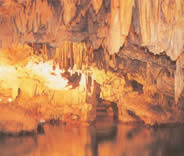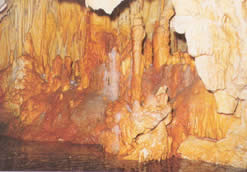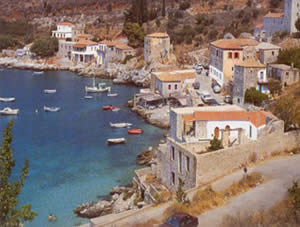Caverns open daily, June-Sept, 8am-5:30pm;Oct to May, 8am-2:30pm; 12euros). The museum (Tues-Sun; 8:30am-3pm; 3 euros) houses interesting Neolithic finds from the caves, with signs only in Greek.

 The Dirou caverns near the village of the same name is the biggest tourist attraction in the Mani.
Located 4km from the village, the caves are filled with water whose depth varies from 2 meters to 20meters. You must
wait your turn to be taken on the little boat tour of the Glyfadha caves, which are well worth seeing, as the roof of
the cave is crowded with stalactites which are reflected in the water. There is also a tour on foot of the Alepopetra
caves, which are enormous chambers which were inhabited during prehistoric times. There is a beach adjacent to the
caves.
The Dirou caverns near the village of the same name is the biggest tourist attraction in the Mani.
Located 4km from the village, the caves are filled with water whose depth varies from 2 meters to 20meters. You must
wait your turn to be taken on the little boat tour of the Glyfadha caves, which are well worth seeing, as the roof of
the cave is crowded with stalactites which are reflected in the water. There is also a tour on foot of the Alepopetra
caves, which are enormous chambers which were inhabited during prehistoric times. There is a beach adjacent to the
caves.
 The 17km stretch of coastal plain between Pyrgos Dhiroou and Yerolimenas is one of the more fertile parts of the
Inner Mani, with dwarf olive trees. There are many villages off of the main road, mostly without facilities-few shops or
public phones. There are many Byzantine churches in this area, dating from the 9th to the 14th centuries. If you are
interested in churches, you might want a copy of the book 'Deep into Mani', by Peter Greenhalgh, since without it,
you'll find them hard to locate. Many are locked, but keys can be asked for. Farther to the south, the small village
of Mezapos has a deep harbor, and was once one of the main settlements of Mani. The building of the modern road has
changed that, as it has made more areas accessible on land.
The 17km stretch of coastal plain between Pyrgos Dhiroou and Yerolimenas is one of the more fertile parts of the
Inner Mani, with dwarf olive trees. There are many villages off of the main road, mostly without facilities-few shops or
public phones. There are many Byzantine churches in this area, dating from the 9th to the 14th centuries. If you are
interested in churches, you might want a copy of the book 'Deep into Mani', by Peter Greenhalgh, since without it,
you'll find them hard to locate. Many are locked, but keys can be asked for. Farther to the south, the small village
of Mezapos has a deep harbor, and was once one of the main settlements of Mani. The building of the modern road has
changed that, as it has made more areas accessible on land.
There is a nice walk to the 12th century church of Vlaherna, which has some fragments of frescoes. Stavri has rooms in traditional tower houses which are larger and in a more dramatic setting than those in Areopoli and Vathia. You can walk from this village to the 12th century church of the Episkopi, also with frescoes (though faded), and columns with Ionic capitals and a marble arch at the entry to iconostasis. The deserted village of Aghia Kyriaki has good views, and access to Tigani (Frying Pan) Peninsula with its fortress that seems to have been the main Castle of the Maina (Mani), constructed by the Frankish baron Guillaume de Villehardouin, who also constructed those of Mystra and Monemvasia, all of them ceded to the Byzantines in 1261. Inside its walls are ruins of a huge Byzantine church and many cisterns. The site is very arid.